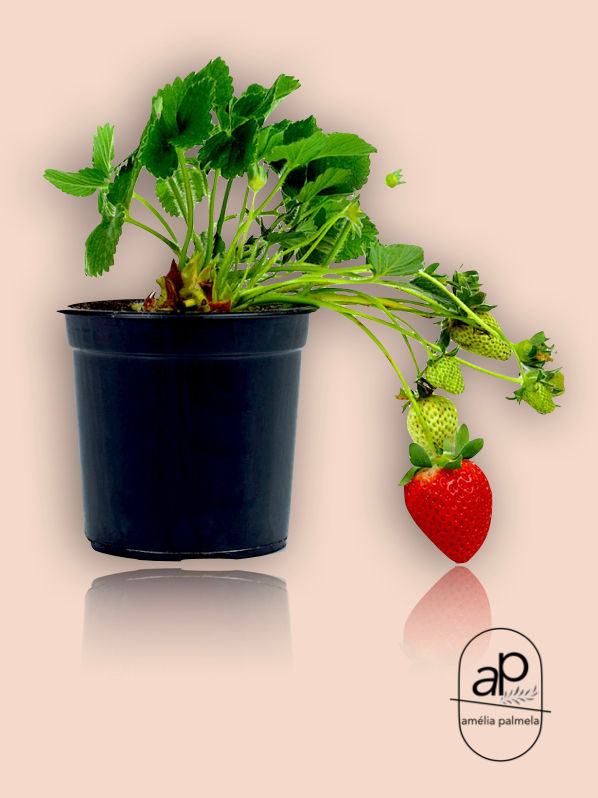'Camarosa'
No Upstream or short day
The Camarosa variety was released in 1992 by the University of California, USA. Its fruits are large, firm, have a good flavor and are resistant to transport. Currently, the Camarosa cultivar is the most widespread in our country. It is a vigorous plant, with an intermediate-erect shape. It has a moderate tolerance to limescale and some fungal diseases of the root and aerial part.
It has long inflorescences, which makes it easy to harvest. The fruits have a medium to high caliber, with an average weight of around 20 g and an intense red colour.
Strawberries have an elongated conical or conical shape. They are sweet and have a medium to good taste quality.
They are a little less aromatic than the Chandler cultivar, however, they are substantially more consistent, which provides good transport resistance and good conservation aptitude.
Benefits
It is the most cultivated variety in recent years, estimated at 60% of world production.
Robust plant with great vegetative vigor and great tillering. Care should be taken with excess nitrogen, which could unbalance the development of the plant, making aeration difficult and reducing the quantity and size of the fruits, as well as favoring their rot.
It presents an excellent climatological adaptation, from humid subtropical regions to Mediterranean regions, such as Portugal, Spain and Morocco.
It continues to be the variety preferred by the world industry.
It has large, firm and tasty fruits with an intense red color.
Main features:
▪ great climatological adaptation
▪ early variety
▪ productive and with great fruit quality: colour, size and firmness.
'Monterey'
Strawberry "Monterey" by description is similar to the variety "Albion" - and this is its direct descendant, grown at the California Institute in 2009. From an ancestor of a strawberry it differs in softer consistency of pulp and a richness of taste .
The bushes are powerful, moderately leafy, with glossy, glossy green leaves. Each bush is formed from 7 to 14 peduncles. The berries are conical with a regular shape, shiny, bright red. Gardeners note that the strawberry of the second wave of fruiting favorably differs in taste from the first and subsequent ones. Grade yield: from 500 to 2000 grams per bush.+
This variety (like other Californian breeding varieties) is afraid of frost and requires shelter for the winter and early spring. The disease is reasonably stable.
'Albion'
This is one of the most “famous” varieties among all existing ones. The Albion variety is characterized by its exceptional organoleptic quality and by having a very interesting conservation power. As it is recurrent, needs longer days to induce flowering and produce strawberries. Strawberries of this variety can be obtained for much of the year, especially throughout summer and part of autumn. The flesh of these strawberries is quite dense and has a very good flavor.
Strawberries of this variety are resistant to diseases such as anthracnose, verticillium, phytophthora as well as pests like the red spider. In edaphic terms, strawberry plants of this variety like soil rich in organic matter, light and loose. They also like sun exposure so make sure you grow this variety in a sunny location.
High resistance to adverse weather conditions and diseases.
'San Andreas'
This variety, characterized by perennial plants, also produces some of the best strawberries.
Main features:
Very firm fruit, more than Candonga, with a bright medium red color and excellent flavor and aroma.
Sensitive to boron deficiency.
Early plantings to develop lateral crowns in a 25x25 cm spacing
Use a base fertilizer that has between 15-20% N and between 8-15% P and K according to soil analysis.
Very precocious and productive, but the plant must be helped to develop lateral crowns before bearing its first fruits.
Cut the first flowers and stolons to stimulate growth, they need 2 or 3 lateral crowns before fruiting.
Greater water intake, always keep the mixture moist.
Start a foliar nutrition program 2-3 weeks after planting.
Over the next 6-8 weeks, apply plenty of N to develop lateral crowns.
Then decrease the dose of N and increase the amount of K and P
DO NOT APPLY GIBBERELLIC ACID
Description:
SAN ANDREAS is a moderately neutral (remounting) daytime variety with excellent fruit quality (similar to Albion), excellent flavor, little need for chilling in the nursery, disease resistant.
It is earlier than Camarosa in autumn planting, with a production curve without peaks and stable throughout the cycle, it maintains size until the end of the campaign and very good production.
SAN ANDREAS can mean for the farmer the best variety to keep fewer workers per hectare for a longer time and avoid the abandonment of the land due to lack of labor in the months of greater production.
SAN ANDREAS adapts very well to different types of plantings (pots, cellars, fresh, frozen), planting dates and fruit production throughout the year in different countries around the world.
Possibly the first neutral day variety to cater to the short day variety markets.
Produces far fewer stolons than Albion when fruiting.
Resistance to diseases and pests:
Phytophthora and Anthracnose very resistant.
Less incidences of botrytis and powdery mildew, with changeable weather.
Morangueiro (Fragraria Hybrida)
Vase 10.5 cm
